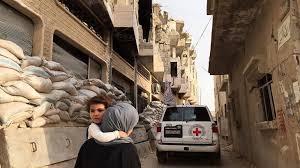As part of the policy of demographic change that the Syrian state and its allies are pursuing in areas opposed to the Assad family’s rule, agents of the Assad regime are offering to buy property from residents in the Homs and Hama countryside for the benefit of Iranian “investors.”
According to sources, this process began directly after the regime, Russia and Iran concluded the forcible displacements of Syrian opposition members and residents who refused to remain under Assad’s rule in the northern Homs and the southern Hama countrysides.
Regime brokers are trying to buy homes and land for regime members of the Iranian and Syrian leadership and for individuals from the Alawite and Shia sects to bring about a demographic change in the area and ensure that they remain under the regime’s wings.
Sada al-Sham spoke with a number of residents who said that they and their relatives were contacted by the regime and offered money for destroyed or whole properties for varying amount, depending on the type of property.
Abu Mohamed, one of the residents who remained in the city of al-Rastan in the northern Homs countryside, told Sada al-Sham that the area’s officials and notable agents of the regime had recently entered rural Homs and Hama and have begun to act as brokers for buildings which have been completely destroyed and for homes which were damaged by regime bombardment.
He added that these figures used the internet to contact his relatives who had been displaced to northern Syria in order to work as an agent for one of their relatives after offering a price, adding that they “offered low prices because the buildings were destroyed.”
Abu Mohamed did not confirm that sales with displaced people were made, but he did say that the buyers were Iranian investors and “Shia” traders and pro-regime traders from Damascus, and that they were supporting the militias that were fighting alongside regime forces.
He said that the brokers were “notables and officials” belonging to the Baath Party whose job was to reconcile sales between investors and sellers.
Abu Mohamed said that in an attempt to compel people to sell, Baath brokers offered attractive amounts of money to the residents who refused to leave al- Rastan and chose to stay under Assad.
Other incentives were offered to residents to try and get them to sell. Sellers promised to give them a home in a new building with new good quality furniture, relieving them of the burden of finding new furniture for homes destroyed by regime mortars and missiles.
The sales process is conducted through the owner or through an agency in the regime’s municipal government which has recently returned to work after the displacement process.
Nidal al-Omar, a media activist working in the Homs countryside, said that making a profit is not their ultimate goal, but rather to control the largest portion of these regions and the properties within and to prevent displaced people from returning in the near future.
He added: “Buying these wide areas will prevent thousands from returning to their regions, as they no longer have shelter or anything connecting them to the place. In addition, those who refuse to sell to these traders and choose to return and settle with the regime will not find themselves in the area that they once knew and lived in. Most of these buildings will be owned by Iranian soldiers and regime loyalists, converting the area into a loyalist area, which will not be able to oppose the regime again after this demographic planning.”
The Iranians are focusing on pushing in this area because it is close to the Iranian center in Hama, which is the Brigade 47, the center for the Iranian Revolutionary Guard militias and their officers in the Hama province, which works on administering military operations in the area. It also contains Syrian civilian volunteers in the Iranian Guard.
This parallel effort — to transform the area demographically to convert it into a loyalist area and to transform it into houses for Iranian and Lebanese fighters and their families — will secure the most important routes connecting the cities of Homs and Hama in central Syria. After being deprived of these strategically important routes for a long period, the regime understands their importance.
The regime is working to secure these areas, and to install those whose loyalty is ensured, which still include Sunni populations who could rebel against the regime in the future.
This article was translated and edited by The Syrian Observer. Responsibility for the information and views set out in this article lies entirely with the author.


